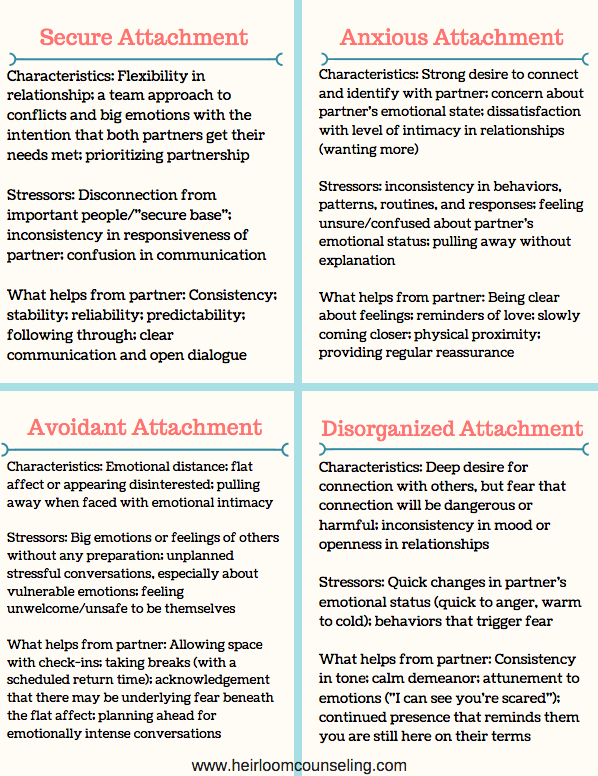What You and Your Partner Need to Know to Resolve Arguments
Hello!
I'm excited to be back with you this week to share more about attachment styles and how we can be more connected, responsive, and present in our relationships with each other. These qualities make a huge difference in how our relationships feel, how our families operate, and our general outlook on life. Thanks for being here with me! And as always, if you have any questions you are welcome to leave them in the comments or email me!
Now that we've explored what it means to be attached in relationships and you know your attachment style, I want to spend some time this week talking about what each style needs to thrive in relationships--especially when conflict is present and one of you is feeling triggered (we will talk more about the anxious/avoidant cycle next week and what to do when you're both triggered, because it's a little more complex!).
This week's blog is a little different, because in order to fully understand these concepts, they need to be put into practice. I could tell you about them until I'm blue in the face but they don't make much of a difference in your day-to-day until you try them yourself. So I'm going to give you some context, a short video, and a tool for you to download and print if you feel so inclined! I tell my clients that fridge space isn't just for your kiddo's art work; you can use it to remind yourselves of your goals for your relationship and in this case, what the other needs when you're feeling frustrated, upset, and disconnected and you need a little cheat sheet to get you through it.
Each person responds a bit differently when their primary attachment style comes forward. Like we discussed last week, everyone has a little slice of each style in their "attachment pie", but we all tend to have a primary insecure style that shows up when we feel disconnected from our partner, family member, or community. When this style comes forward, it's important for us to notice for ourselves and our partner what themes, behaviors, and language is present, because this will give us a clue in the future that we are moving into a more insecure place and will need some support in getting more grounded.
For example, in a moment of disconnection, a person with a primary insecure style of anxious might look angry, become critical of their partner, and say things like "you always do this; I knew from the beginning that you didn't really love me." From this comment, we can tell that they are feeling activated, their nervous system is on high alert, and they are operating from a place of fear and abandonment. During a moment of disconnection, a person with a primary avoidant style may throw their hands up and say "you know what, I'm done" and then physically walk out of the room. If they're able to stay present in the situation, may go silent, avoid eye contact, and look as though they have left their body and you're seeing the shell of them. This tells us that they are feeling overwhelmed, overstimulated, and trying to take space from the emotional stimuli they're experiencing.
It's also helpful for us to have scripts to use with our partners to help communicate our needs clearly; I will link to some scripts for avoidant and anxious attachment styles at the end of this post! I have also created a Support Bundle for Working Through Disconnection to provide a step by step guide to managing arguments and reconnecting more quickly and effectively. It’s low-cost and includes 5 worksheets (that you can reuse over and over again!) and an audio component that supports you and your partner in calming down and getting to the root of the disconnection between you.
I've created this attachment style reference worksheet for you to use in your relationship. It outlines the qualities of each style, emotional triggers, and what each style needs to feel calmer, more comfortable, and able to re-connect. This is a place to start; you will find that as you become more attuned to your partner, more aware of what happens for them when they feel disconnected from you, you will be able to identify more strategies to support them and more quickly repair the disconnect. It's an incredible process, and one that will bring you closer together.
Scripts for Soothing: Avoidant Attachment Adaptation
Scripts for Soothing: Anxious Attachment Adaptation
I can't wait to hear how this goes for you! Please let me know if this is helpful, and what you'd like more of!
Here's to healthy relationships and re-connecting!
Love,
Elizabeth
Are you ready to work on your relationship? I created a free checklist to help you be the best partner ever. I write about healthy relationships each week and would love to keep you in the loop.
You may also be interested in:
A Love Letter to the Insecurely Attached
The Intersection of Attachment and Social Justice
When You Are Triggered in Your Relationship
Do You Know Your Attachment Style?
What does it mean to be attached? Why does attachment matter?

